Concrete is the most commonly used man-made material on Earth. From dams, to bridges to culverts, concrete is everywhere that you look. Concrete is a composite, made from portland cement and water, with a filler of aggregate material (sand or gravel). Because of its makeup, concrete can be very strong under compression loads, but does not hold up as well to shear loads and is not a good design material for tension loads.
This creates a design challenge when trying to connect other materials to concrete building components or structures. The most commonly used connection to concrete in commercial construction is the connection between steel and concrete, as when you connect a steel beam to a concrete wall, concrete floor or concrete column.
The steel to concrete connection can be a difficult one to engineer and design. When you are connecting steel beams to concrete, you are introducing a load that’s concentrated in a small area, and this load may be in shear or may produce a moment that puts some part of the connection point in tension. These steel to concrete connection points must be carefully designed and reliably constructed in order for the structural system to meet applicable Codes and be safe and durable for the long run.
To make a connection between steel and concrete, as in when you connect a structural steel beam to concrete you commonly use concrete embeds, such as a concrete embed anchor or a steel embed plate (sometimes also called embedment plate or embedded plate).
As with virtually every engineering design decision, there are pros and cons to each of these solutions.
Concrete Embed Anchors
Concrete embed anchors are one type of concrete embed often used to connect structural steel, and other design elements such as awnings to a concrete structure or structural component.
There are three general types of concrete embed anchors, cast in place, mechanical post-installed and adhesive post-installed.
Cast In Place Concrete Embed Anchors
Cast in place concrete embed anchors, being positioned before the wet concrete pour are locked in place when the concrete cures.
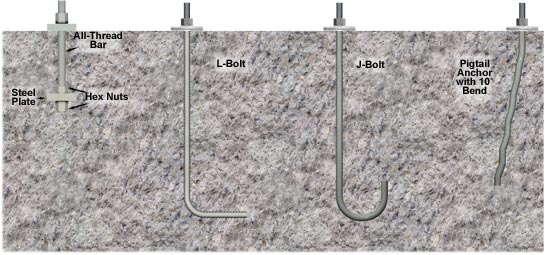
Examples of Typical Cast in Place Concrete Embed Anchor Types - Courtesy Williams Form Engineering Corp.
Cast in place concrete embed anchors are generally ‘non-proprietary’ and can be a regular hex head bolt with the head embedded or can be L-shaped, J-shaped and T-shaped. On a fast track job it’s possible that the concrete foundation may be designed and the embed anchor locations not be detailed yet so post-installed anchors have to be used.
Post Installed Concrete Embed Anchors
Post installed concrete embed anchors come in two types, Mechanical Embed Anchors and Adhesive (or Bonded) Embed Anchors.
Mechanical Concrete Embed Anchors
There are a wide variety of mechanical concrete embed anchors available to designers and contractors. Each is designed to solve a particular construction challenge.
Some Commonly Used Types of Mechanical Concrete Embed Anchors:
Screw Anchors: Best in dry, indoor conditions. High performance in masonry or concrete base materials.
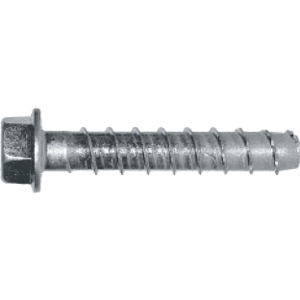 Example of Screw Anchor Cast in Place Concrete Embed Anchor
Example of Screw Anchor Cast in Place Concrete Embed Anchor
Wedge Anchors: Good for strength, rust resistance, and easy use. This anchor goes into a hole drilled to wedge width but is longer than the bolt and the wedge opens when bolts are tightened securing the bolt.

Example of Wedge Anchor Cast in Place Concrete Embed Anchor
Sleeve Anchors: Commonly used in brick and concrete. The external casting flares at the base to hold the bolt in place and when tightened flares out.
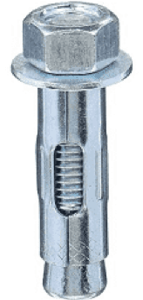
Example of Sleeve Anchor Cast in Place Concrete Embed Anchor
Leadwood Screw Anchors: Good for brick, poured concrete, or concrete blocks. They surround a sheet steel bolt and longer ones can be used on softer materials.
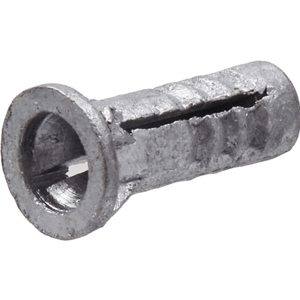 Example of Leadwood Screw Anchor Cast in Place Concrete Embed Anchor
Example of Leadwood Screw Anchor Cast in Place Concrete Embed Anchor
Double Expansion Anchors: These anchors have flanges that expand at the top and the base of the anchor to help resist the effects of vibration to prevent screws backing out.
 Example of Double Expansion Anchor Cast in Place Concrete Embed Anchor
Example of Double Expansion Anchor Cast in Place Concrete Embed Anchor
Adhesive Concrete Embed Anchors
Adhesive concrete embed anchors are placed after the concrete is poured. A hole is drilled in the concrete where the anchor is to go and the anchor is locked in place with an adhesive. While the installation of an adhesive anchor can be more labor intensive, an advantage is that placement mistakes can be avoided, as once an anchor is cast into place, it’s difficult to move the anchor location.
Types of Adhesives for Adhesive Embed Anchors
There are two common types of adhesive embed anchors, epoxy and acrylic. There are tradeoffs between applying one type of embed anchor adhesive vs. the other.
In general:
Epoxy Embed Anchor Adhesive :
Longer gel and cure times but higher bond strength, particularly in damp conditions. Longer gel times may be useful when injecting the epoxy into deep drilled holes, but harder to use below 60 Def. F.
Acrylic Embed Anchor Adhesive:
Shorter gel and cure times but lesser bond strength, particularly in damp conditions. Useable temperatures down to 14 Deg. F but can’t be stored above 80 Deg. F.
A list of pros and cons for each type of adhesive, as provided by Strongtie is below:
| Type of Post Install Concrete Embed Anchor Adhesives | |
|
Epoxy |
Acrylic |
|
Long gel times |
Short gel times |
|
Long cure times |
Short cure times |
|
Long Shelf Life (2 years) |
Shorter shelf life (1 Year) |
|
High storage temperature |
High-end storage temperature is capped at 80°F(product quality may be compromised when storage temperatures exceed 80°F |
|
Good damp-hole performance |
Reduced performance in damp holes |
|
Higher bond strengths |
Bond strengths are usually lower |
|
Low temperature installations (14°F) |
|
|
Difficult to dispense at temperatures below 60°F |
Good pump-ability at low temperatures |
|
Low-temperature storage (14°F) |
|
|
Reduced performance at elevated temperatures |
Very good elevated-temperature performance |
|
Long nozzles required to achieve proper mixing |
Shorter nozzles are compatible |
|
Large-volume cartridges can be dispensed with manual dispensing tools |
|
|
More of a gel consistency, making the use in horizontal and overhead applications easier |
|
|
Adhesive does not shrink, allowing it to be used in oversized holes. |
|
|
Low temperature is restricted to 40°F |
|
|
Very stable chemistry |
|
Although adhesive concrete embed anchors can be installed after the fact which is easier for alignment, they can be very labor intensive to install and require experienced technicians.
More About Concrete Embed Anchors
Embed anchor failures occur differently in tension and in shear.
In tension, failure can happen by:
The steel anchor component breaking
The steel anchor pulling out of the concrete
Concrete cone breaking out after capacity is reached
Concrete cracking, dividing the base material
Concrete blowout failure, causing lateral spalling of the concrete
In shear, failure can happen by:
Steel rupture after reaching capacity and yield
Semi conical fracture shape at the bearing point
Pry out of a semi-conical shape under direct shear load
Concrete Embed Plates
For higher structural loads than a concrete embed anchor is capable of, engineers specify concrete embed plates. A concrete embed plate is a metal plate with bolts, studs or rebar connected to it. Each of these elements is an anchor, so an embed plate can have multiple anchors, increasing its load bearing capacity. The plate is set into wet concrete elements such as flooring, piers, precast columns or tilt-up walls, concrete slabs or poured in place concrete walls to create a connection point.
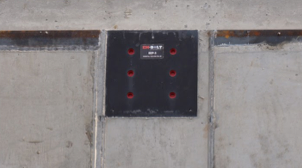
An Example of a Concrete Embed Plate in Place After Pour
Having multiple components embedding into the concrete, a concrete embed plate has substantially more load bearing capacity than a concrete embed anchor.
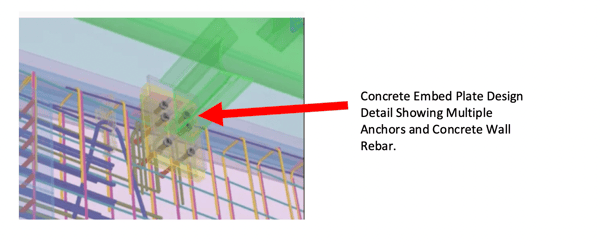
Concrete Embed Plate Design Detail Showing Multiple Anchors and Concrete Wall Rebar
There are two types of concrete embed plate, traditional welded concrete embed plates and patented new EM-BOLT boltable concrete embed plate designs
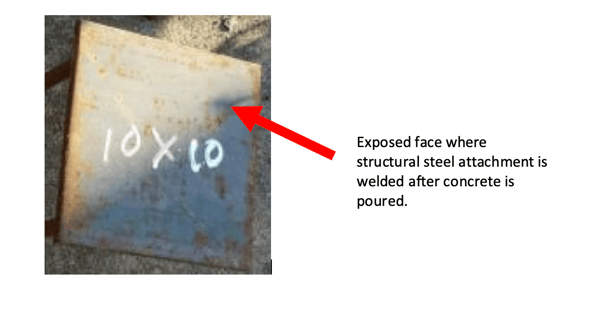 Example of a Traditional Welded Concrete Embed Plate Exposed Face
Example of a Traditional Welded Concrete Embed Plate Exposed Face
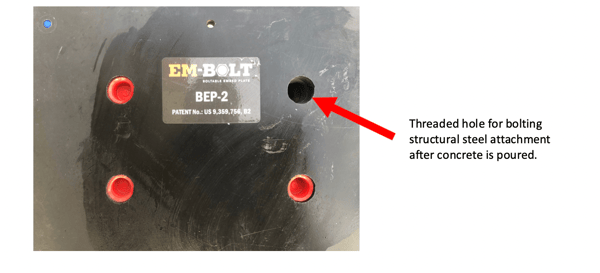 Example of new Style EM-BOLT Boltable Concrete Embed Plate Exposed Face
Example of new Style EM-BOLT Boltable Concrete Embed Plate Exposed Face
Traditional Welded Concrete Embed Plates
In the past, there was only one option for concrete embed plates, weldable. In this configuration, the embed plate is placed into the concrete forms and allowed to cure in place. The embed plate face is exposed after the forms are removed and a bracket is field welded to it in order to enable structural members such as beams to be connected to it.
New EM-Bolt Boltable Concrete Embed Plates
The design of the new EM-BOLT boltable embed plate as shown in the image above reveals protective plastic caps covering pre-drilled and threaded holes in the faceplate once the concrete form is removed. After removal of the plastic caps, the structural element to be connected to the concrete via the concrete embed plate is bolted, rather than welded, into place.
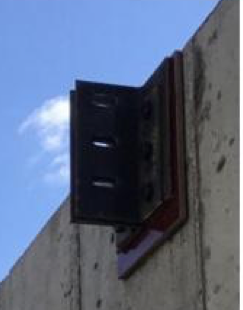
New Boltable Concrete Embed Plate with Structural Steel Bracket Bolted in Place
This new, patented configuration of concrete embed plate delivers an installed cost that is less than a standard welded concrete embed plate and provides numerous on site construction advantages.
When an Estimator, Owner or Contractor sees concrete embed plates on design drawings they count them up as individual pieces and assign a cost for setting each of them in place which includes the cost of each component, the cost of installation labor and the cost of inspection.
In the case of traditional concrete embed plates, the cost of field welding brackets to the plate faces can be considerable. The concrete embed plates are typically high up off the floor, necessitating that a ladder be used for both welding and inspection. Welding requires equipment to be near the weld which on a ladder can be difficult. Welding can also be difficult to perform in inclement weather, resulting in projects being delayed or safety being compromised to keep projects on track. A portion of welds will be inspected and in some cases LPT or XRay inspection may be required, driving time and costs. Additional costs are incurred for flawed welds that need to be ground out and redone.
The new boltable concrete embed plate provides labor savings by freeing field welding skilled labor to perform other work, as the connection between steel and concrete is bolted rather than welded. Bolted joints also save inspection cost and risk vs field welded joints. The new boltable concrete embed plate designs allow new building energy codes to be met by enabling new thermal break technologies to be integrated into the embed plates.
In the case of both types of concrete embed plates, Structural Engineers will calculate the design load required at the steel to concrete connection point and need to select a concrete embed plate (embedded plate) that will safely carry the design loads. Factors that are taken into account are the type of concrete being specified, the steel material, the diameter and number of anchors from the plate into the concrete and the steel plate thickness. A concrete embed plate is designed in accordance with ACI 318-14, Chapter 17.
Design software is available for detailing concrete embed plates, and you can see examples of embedded plate design calculations for HILTI Profis™ here and Simpson Strong-Tie Anchor Designer™here. However, when using EM-BOLT concrete embed plates our registered structural engineers will perform the design detail calculations for you!
Interested in learning more about how EM-BOLT boltable embed plates save construction costs and time? Take advantage of the Guide below!
Would you like help with your concrete embedded plate engineering calculations? Reach out to us below.
Embedded plate Revit drawings of our standard series of products are also available, for Revit drawings go here.
To learn more about the advantages of EM-BOLT Boltable Embedded Plates, go here.
We also provide patented energy saving thermal break embedded plate solutions that make it possible for you to meet new code requirements and save energy costs while still reducing construction cost and timeline risk.





